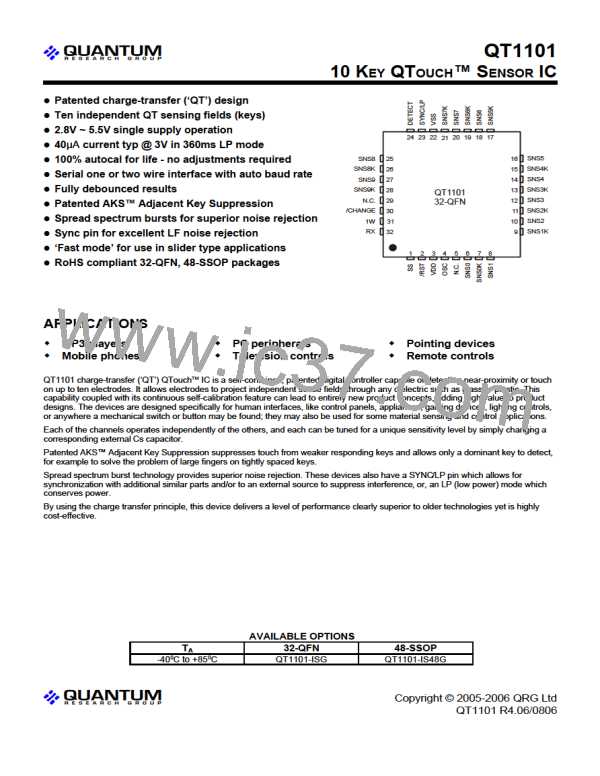A trigger pulse on SYNC will cause the device to fire three
acquire bursts in A-B-C sequence:
2 Device Operation
Burst A: Keys 0, 1, 4, 5
Burst B: Keys 2, 3, 6, 7
Burst C: Keys 8, 9
2.1 Startup Time
After a reset or power-up event, the device requires 450ms
to initialize, calibrate, and start operating normally. Keys will
work properly once all keys have been calibrated after reset.
Low Power (LP) Mode: This allows the device to enter a
slow mode with very low power consumption, in one of three
response time settings - 120ms, 200ms, and 360ms
nominal.
2.2 Option Resistors
The option resistors are read on power-up only. There are
two primary option mode configurations: full, and simplified.
LP mode is entered by a positive pulse on the SYNC/LP pin.
Once the LP pulse is detected, the device will enter and
remain in this microamp mode until it senses and confirms a
touch, upon which it will switch back to normal (full speed)
mode on its own, with a response time of <40ms typical
(burst length dependent). The device will go back to LP
mode again if SYNC/LP is held high or after another LP
pulse is received.
In full options mode, seven 1M✡ option resistors are
required as shown in Figure 1.1. All seven resistors are
mandatory.
To obtain simplified mode, a 1M✡ resistor should be
connected from SNS6K to SNS7. In simplified mode, only
one additional 1M✡ option resistor is required for the AKS
feature (Figure 1.2).
The response time setting is determined by option resistors
SL_1 and SL_0 (see Table 1.5). Slower response times
result in lower power drain.
Note that the presence and connection of option resistors
will influence the required values of Cs; this effect will be
especially noticeable if the Cs values are under 22nF. Cs
values should be adjusted for optimal sensitivity after the
option resistors are connected.
The SYNC/LP pulse should be >150µs in duration.
If the SYNC/LP pin is held high permanently, the device will
go into normal mode during a key touch, and return to
low-current mode after the detection has ceased and the key
state has been read by the host.
2.3 DETECT Pin
DETECT represents the functional logical-OR of all ten keys.
DETECT can be used to wake up a battery-operated product
upon human touch.
If the SYNC/LP pin is held low constantly, the device will
remain in normal full speed mode continuously.
The output polarity and drive of DETECT are governed
according to Table 1.4, page 4.
2.6 AKS™ Function Pins
The QT1101 features an adjacent key suppression (AKS™)
function with two modes. Option resistors act to set this
feature according to Tables 1.2 and 1.6. AKS can be
disabled, allowing any combination of keys to become active
at the same time. When operating, the modes are:
2.4 /CHANGE Pin
The /CHANGE pin can be used to tell the host that a change
in touch state has been detected (i.e. a key has been
touched or released), and that the host should read the new
key states over the serial interface. /CHANGE is pulled low
when a key state change has occurred.
Global: The AKS function operates across all ten keys. This
means that only one key can be active at any one time.
Groups: The AKS function operates among three groups of
keys: 0-1-4-5, 2-3-6-7, and 8-9. This means that up to
three keys can be active at any one time.
/CHANGE is very useful to prevent transmissions with
duplicate data. If /CHANGE is not used, the host would need
to keep polling the QT1101 constantly, even if there are no
changes in touch. Upon detection of a key, /CHANGE will
pull low and stay low until the serial interface has been
polled by the host. /CHANGE will then be released and
In Group mode, keys in one group have no AKS interaction
with keys in any other group.
return high until the next change of key state, either on or off , Note that in Fast Detect mode, AKS can only be off.
on any key (Figures 2.1, 2.4).
The /CHANGE pin is open-drain, and requires a ~100K
pullup resistor to Vdd in order to function properly.
2.7 MOD_0, MOD_1 Inputs
In full option mode, the MOD_0 and MOD_1 resistors are
used to set the 'Max On-Duration' recalibration timeouts. If a
key becomes stuck on for a lengthy duration of time, this
feature will cause an automatic recalibration event of that
specific key only once the specified on-time has been
exceeded. Settings of 10s, 60s, and infinite are available.
2.5 SYNC/LP Pin
The SYNC / LP pin function is configured according to the
SL_0 and SL_1 resistor connections to either Vdd or Vss,
according to the Table 1.5.
The Max On-Duration feature operates on a key-by-key
basis; when one key is stuck on, its recalibration has no
effect on other keys.
Sync mode: Sync mode allows the designer to synchronize
acquire bursts to an external signal source, such as mains
frequency (50/60Hz), to suppress interference. It can also be
used to synchronize two QT parts which operate near each
other, so that they will not cross-interfere if two or more of
the keys (or associated wiring) of the two parts are near
each other.
The logic combination on the MOD option pins sets the
timeout delay; see Table 1.3.
Simplified mode MOD timing: In simplified mode, the max
on-duration is fixed at 60 seconds.
The SYNC input is positive pulse triggered. If the SYNC input
does not change, the device will free-run at its own rate after
~150ms.
Lq
6
QT1101 R4.06/0806

 QUANTUM [ QUANTUM RESEARCH GROUP ]
QUANTUM [ QUANTUM RESEARCH GROUP ]